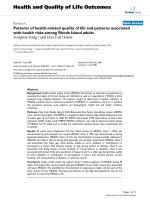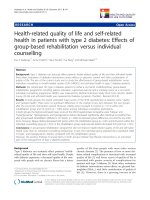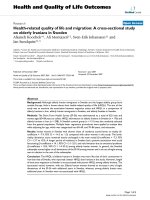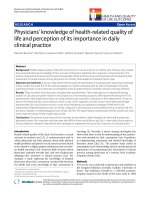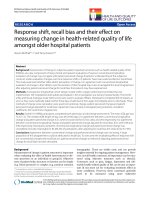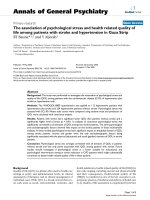Health related quality of life and pharmacoeconomics amongst asian parkinson¿s disease patients in singapore
Bạn đang xem bản rút gọn của tài liệu. Xem và tải ngay bản đầy đủ của tài liệu tại đây (1.27 MB, 200 trang )
HEALTH RELATED QUALITY OF LIFE AND
PHARMACOECONOMICS AMONGST ASIAN
PARKINSON’S DISEASE PATIENTS IN SINGAPORE
ZHAO YINGJIAO
(B.Sc., Shenyang Pharmaceutical University)
A THESIS SUBMITTED
FOR THE DEGREE OF DOCTOR OF PHILOSOPHY
DEPARTMENT OF PHARMACY
NATIONAL UNIVERSITY OF SINGAPORE
2010
i
ACKNOWLEDGEMENTS
There are a number of people without whom this thesis might not have been
written, and to whom I am greatly indebted. I would like to take this opportunity to
express my deepest gratitude and appreciation to my supervisor, Prof. Li Shu Chuen.
He showed me the way to write academic papers as well as to be an independent
researcher. More importantly, he taught me how to work hard and play hard and how
to reduce stress, and always had confidence in me when I doubted myself. Special
thanks also go to my supervisor, Dr. Wee Hwee Lin, who was always there to meet
and talk about my ideas and taught me how to make my work unique and outstanding.
I gratefully thank my co-supervisor, Dr. Luo Nan, for his supervision, advice, and
guidance from the very early stage of this thesis. Without their encouragement and
constant guidance, I could not have finished this thesis. Besides this, I very much
appreciate their constant assistance and support on my job hunting.
Many thanks go to my collaborators in Department of Neurology, National
Neuroscience Institute. I specially thank to Dr. Tan CS Louis, for his crucial
contribution in making all of my research work go on smoothly. I would like to thank
other collaborators who are Dr. Au Wing lok and Mrs. Lau Puay Ngoh for their
constant assistance in recruiting study participants and Mrs. Seah Soo Hoon (Irene)
in retrieving data from hospital database.
It is a pleasure to pay tribute to all the staff in the Department of Pharmacy,
National University of Singapore who had given me their hands. I would like to
express my special appreciation to Prof. Chan Sui Yung (Head of Department) for
ii
her support on my scholarship and conferences. Many thanks go to Napsiah Bte
Suyod, Chew Ying Ying, Nor Hazliza Binte Mohamad for their administrative
assistance throughout my journey here.
Loving thanks to my learning partners, Tipaporn Pongmesa (Tina), Ow Yen
Ling (Mandy), Gan Hua Pey, Sow Wei Ting, Lim Yi Ting (Regine), who played
such important roles along the journey, as we mutually engaged in making sense of
the various challenges we faced and in providing encouragement to each other at
those times when it seemed impossible to continue.
Last yet very importantly, I would like to thank my dearest George, my
parents and friends for all the unconditional love, guidance, and support.
iii
TABLE OF CONTENTS
Acknowledgements…………………………………………………………………….i
Table of contents…………………………………………………………………… iii
List of tables……………………………………………………………………… vi
List of figures……………………………………………………………………… viii
Glossary of abbreviations and acronyms………………………………………… ix
Summary…………………………………………………………………………… xi
Publications………………………………………………………………………….xiii
Chapter 1- Introduction… ….…………………………………………………… 1
Overview of Health Related Quality of Life (HRQoL) ………… 2
Overview of Pharmacoeconomics 4
Overview of Parkinson’s Disease…….………………………………………… 6
HRQoL and Pharmacoeconomic Evaluation in Parkinson’s Disease…………….10
Research Objectives………………………………………………………………11
Chapter 2- Factors Affecting HRQoL Amongst Asian Patients with Parkinson's
Disease in Singapore…………………………………………………………… ….13
Introduction……………….……………………………….……………… ……14
Methods… ……………….……………………………….……………… ……15
Results…………………….……………………………….……………… ……18
Discussion ……………….……………………………….……………… ……24
Chapter 3- Determination of the Longitudinal Validity and Minimally Important
Difference of the 8-item Parkinson’s Disease Questionnaire………………… 28
Introduction…… …………….……………………………….…………………29
Methods… …… …………….……………………………….…………………30
Results…………… ………….……………………………….………………….32
Discussion… ……………….……………………………….………………….36
iv
Chapter 4- Progression of Parkinson’s Disease as Evaluated by Hoehn and Yahr
(H&Y) Stage Transition Times… ……………………………………………….40
Introduction…….….………….……………………………….…………………41
Methods… … ……………….……………………………….…………………42
Results………………… …….……………………………….…………………45
Discussion …….…………….……………………………….…………………52
Chapter 5- Economic Burden of Parkinson’s disease in Singapore …………… 57
Introduction…………………………………………………………………… 58
Methods………………………………………………………………………… 59
Results………………………………………………………………………… 65
Discussion…………………….………………………………………………….77
Chapter 6- Estimating the Life-time Economic Burden of Parkinson’s Disease
Using a Markov Model……………………… …………………………………82
Introduction…… …………….……………………………….…………………83
Methods… … ……………….……………………………….…………………84
Results…………… ………….……………………………….…………………88
Discussion …………….…….……………………………….…………………97
Chapter 7- Selegiline Use is Associated with a Slower Progression in Early
Parkinson’s Disease as Evaluated by Hoehn and Yahr Stage Transition
Times………….………………………………………………………………… 100
Introduction…… …………….……………………………….……………….101
Methods… … ……………….……………………………….……………….102
Results…………… ………….……………………………….……………….103
Discussion …………….…….……………………………….……………….109
Chapter 8- Cost Utility Analysis of Selegiline in the Treatment of Parkinson’s
Disease in an Asian Population.……………………………………… …… …112
Introduction…… …………….……………………………….……………… 113
Methods… … ……………….……………………………….……………… 114
v
Results…………… ………….……………………………….……………… 120
Discussion …………….…….……………………………….……………… 138
Chapter 9- A recapitulation of Major Findings, Contributions, Limitations and
Future studies…………………………………………………………………….141
Major findings… …………….……………………………….……………… 142
Major contributions ………….……………………………….……………… 145
Major limitations… ………….……………………………….……………… 147
Future studies ………….…….……………………………….……………… 147
Bibliography……………………………………………………………………….149
Appendices…………………………………………………………………………167
vi
LIST OF TABLES
Table 1.1 Commonly used drugs for the management of PD………………… 8, 9
Table 2.1 Characteristics of study patients………………………………….……18, 19
Table 2.2 Simple and multiple linear regression analysis: effect size of factors on
PDQ8SI scores………………………… …… ……………………………20, 21
Table 2.3 Simple logistic regression analysis: odds ratio of reporting problems with
PDQ-8 dimensions………………………… …… ………………………………22
Table 2.4 Multiple logistic regression analysis: odds ratio of reporting problems with
PDQ-8 dimensions ……… …… ……………………………………………… 23
Table 3.1 Characteristics of study patients at baseline……………………………….33
Table 3.2 Responsiveness and test-retest reliability of PDQ-8SI scores…………….35
Table 4.1 Baseline characteristics of participants for each H&Y stage transition… 46
Table 4.2 Percentages of participants who progressed from one H&Y stage to the next
stage over 72 months ………………………………………………………………49
Table 4.3 Cox regression analysis: hazard ratio for variables associated with
progression in PD.………………………….……………………………………… 51
Table 5.1 Characteristics of study patients at baseline………………………… 65, 66
Table 5.2 Breakdown of cost incurred by PD patients over a 12-month period…69, 70
Table 5.3 Simple and multiple linear regression analysis: effect size of factors on cost
incurred by PD patients over a 12-month period…………………………………73-76
Table 6.1 Breakdown of cost incurred by a cohort of PD patients (mean age=66) over
a 5-year, 10-year, 15- year and life time period….……………………………90, 91
Table 6.2 Cost components for each H&Y stage……………………………… 93, 94
Table 6.3 Transition probability from one H&Y stage to the next or death during 1
year period……………………………………… ………………………………… 95
Table 6.4 Probabilistic sensitivity analysis for cost and transition probability
parameters……………………………………………………………………………96
Table 7.1 Cox regression analysis: hazard ratio for variables associated with
progression in PD………………………………………….……………104-106
Table 8.1 Characteristics of patients who did and did not receive selegiline………121
vii
Table 8.2 Model Parameters by H&Y stages………………………………….122, 123
Table 8.3 Transition probability from one H&Y stage to the next or death…… …126
Table 8.4 Life time cost utility between selegiline and non-selegiline treated
patients…………………………………….………………………………………127
Table 8.5 One-way sensitivity analysis……………………………………… 128-135
Table 8.6 Probabilistic sensitivity analysis…………………………………………136
viii
LIST OF FIGURES
Figure 4.1 Progression between different H&Y stages including transition between
various H&Y stages……………………….…………………………………………48
Figure 6.1 State transition diagram for Markov model…………………………… 87
Figure 4.1 Transition from stage 2 to 2.5 and 2.5 to 3 categorized by duration of
selegiline use…………………………… ………………………………………108
Figure 8.1 State transition diagram for Markov model…………………………… 117
Figure 8.2 Tornado diagram……………………………………………………… 137
ix
GLOSSARY OF ABBREVIATIONS AND ACRONYMS
95%CI
- 95% confidence interval
ADL - activities of daily living
BDI - beck depression inventory
CBA - cost-benefit analysis
CEA - cost-effectiveness analysis
CMA - cost-minimization analysis
COI - cost-of-illness evaluation
COMT - catechol-O-methyl transferase
CUA - cost-utility analysis
DA - dopamine agonist
DIF - differential item functioning
EQ-5D - the EuroQol self-report questionnaire
ES - Cohen’s effect size
GRI - Guyatt’s responsiveness index
H&Y stage - Hoehn & Yahr stage
HRQoL - health related quality of life
ICC - intraclass correlation coefficient
ICUR - incremental cost utility ratio
KM - Kaplan Meier
MAO-B - monoamine oxidase type B
MID - minimally important difference
MLR - multiple linear regression
MMSE - mini mental state examination
x
NINDS - the national institute of neurological disorders and stroke
PD - Parkinson’s disease
PDQ-8 - the 8-item Parkinson’s disease questionnaire
PDQ-8SI - the 8-item Parkinson’s disease questionnaire summary index
PDQ-39 - the 39-item Parkinson’s disease questionnaire
PPP - purchasing power parity
PSA - probabilistic sensitivity analysis
QALYs - quality adjusted life years
S&E ADL - Schwab and England activities of daily living
SD - standard deviation
SF-36 - the short form 36 health survey
SGD - Singapore dollars
SLR - simple linear regression
SRM - standardized response mean
UPDRS - unified Parkinson’s disease rating scale
USD - US dollars
VAS - visual analogue scale
xi
SUMMARY
Parkinson’s disease (PD) is a chronic neurodegenerative disorder which is
characterized by motor disability as well as non-motor impairment including
cognitive, emotional, sensorial and autonomic aspects. Self-reported Health Related
Quality of Life (HRQoL) of PD patients is increasingly being recognized as an
important outcome measure in assessing patients’ well-being. Being a chronic disease
with much impact on a patient’s functional status and well being, PD exerts a
substantial economic burden to society as a whole. Coupled with the increasing
prevalence of PD, a better understanding of the pharmacoeconomics issues related to
PD is important. However, evidence for disease impact on HRQoL and
pharmacoeconomics of treatments in Asian PD patients is lacking. The aims of this
thesis were therefore to evaluate the impact of disease on HRQoL and
pharmacoeconomic outcomes among Asian patients with PD.
In the first part of this thesis, we measured HRQoL and identified factors that
were associated with HRQoL among PD patients in a cross-sectional study. We then
went on to evaluate if the 8-item Parkinson’s Disease Questionnaire (PDQ-8) is
capable of detecting important changes in HRQoL for it to be incorporated in
longitudinal studies. In addition, we estimated the minimally important difference in
change score of PDQ-8 to facilitate interpretation of HRQoL scores by end users such
as clinicians and patients. In summary, we found that both socio-demographics such
as survey language and clinical variables such as duration and severity of PD were
associated with HRQoL among Asian patients with PD. Additionally, we found the
PDQ-8 to be a reliable and responsive measure for assessing changes in HRQoL over
time among patients with PD. The MID of the PDQ-8 was found to range from 5.8 to
xii
7.4 points, thus setting a reference benchmark to facilitate the use of the instrument in
clinical practice.
In the second part of the thesis, we evaluated the annual and lifetime cost of
PD. In addition, we also performed a cost-effectiveness analysis of selegiline (an anti-
parkinsonian alternative) over other anti-parkinsonian drugs. Economically speaking,
our study showed that PD exerted a considerable economic burden on society with a
total cost of between SGD26-46 (USD purchasing power parity (PPP) 23-41) million
per annum in Singapore. Additionally, total life-time economic burden in a cohort of
Singaporean PD patients amounted to be SGD61206 (USD PPP 54648) per patient.
These monetary values would provide a base for comparison of cost-benefit of newer
but more expensive management strategy for PD. In the cost-effectiveness analysis,
selegiline was found to be cost-effective in reducing disease progression.
In conclusion, we have contributed new knowledge with regards to PD
management in Singapore and the findings from this thesis will potentially facilitate
rational medical decision making by incorporating both economic and humanistic (i.e.
HRQoL) outcomes in addition to clinical outcomes. The findings in
pharmacoeconomic evaluations are expected to contribute towards the development
of pharmacoeconomic guidelines in Singapore as well as benefit other countries in the
region that aim to incorporate pharmacoeconomics data in evidence-based medical
decision making.
xiii
PUBLICATIONS
Published manuscript
1. Zhao YJ, Tan LCS, Au WL, Seah SH, PN Lau, N Luo, Li SC, Wee HL.
Economic Burden of Parkinson’s Disease in Singapore. Accepted pending
revisions by European Journal of Neurology
2. Zhao YJ, Wee HL, Chan YH, Seah SH, Au WL, Lau PN, Pica EC, Li SC, Luo N
and Tan LCS. Progression of Parkinson’s Disease as Evaluated by Hoehn and
Yahr Stage Transition Time. Movement Disorders 2010; 25(6): 702-8.
3. Luo N, Tan LCS,
Zhao YJ, Lau PN, Au WL, Li SC. Determination of the
Longitudinal Validity and Minimally Important Difference of the 8-item
Parkinson’s Disease Questionnaire (PDQ-8). Movement Disorders 2009; 24(2):
183-7.
4. Zhao YJ, Tan LCS,
Lau PN, Au WL, Li SC, Luo N. Factors Affecting Health-
Related Quality of Life amongst Asian Patients with Parkinson’s Disease.
European Journal of Neurology 2008; 15(7): 737-42.
Submitted manuscript
1. Zhao YJ Tan LCS, Au WL, Heng MK, Soh AL, Li SC, Luo N, Wee HL.
Estimating the Life-time Economic Burden of Parkinson’s Disease using a
Markov Model. Under review by Value in Health
2. Zhao YJ, Wee HL, Au WL, Seah SH, Luo N, Li SC, Tan LCS. Selegiline Slows
the Progression in Early Parkinson’s Disease as Evaluated by Hoehn and Yahr
Stage Transition Times. Under review by European journal of Neurology
3. Zhao YJ, Li SC, Tan LCS, Au WL, Luo N, Wee HL. Cost Utility Analyses of
Selegiline in Parkinson’s Disease. Under review by Value in Health
xiv
Conference presentations (presenter underlined)
1. Zhao YJ, Wee HL, Chan YH, Seah SH, Au WL, Lau PN, Pica EC, Li SC, Luo N
and Tan LCS. Progression of Parkinson’s Disease as Evaluated by Hoehn and Yahr
Stage Transition Time. The 13
th
International Congress of Parkinson’s Disease and
Movement Disorders, Paris, France, June 7-11, 2009
2. Zhao YJ, Wee HL, Chan YH, Seah SH, Au WL, Lau PN, Pica EC, Li SC, Luo N
and Tan LCS. Progression of Parkinson’s Disease as Evaluated by Hoehn and Yahr
Stage Transition Time. The 14
th
ISPOR International Conference, Orlando, USA,
May 16-20, 2009
3. Zhao YJ, Wee HL, Chan YH, Seah SH, Au WL, Lau PN, Pica EC, Li SC, Luo N
and Tan LCS. Progression of Parkinson’s Disease as Evaluated by Hoehn and Yahr
Stage Transition Time. The 5
th
American Association of Pharmaceutical Scientists
(AAPS)-NUS Student Chapter Scientific Symposium, Singapore, April 1, 2009 (Oral
presentation)
4. Luo N, Tan LCS,
Zhao YJ, Lau PN, Au WL, Li SC. Determination of the
Longitudinal Validity and Minimally Important Difference of the 8-item Parkinson’s
Disease Questionnaire (PDQ-8). The 22
nd
Federation Asian Pharmaceutical
Associations Congress (FAPA2008), Singapore, November 7-10, 2008 (Oral
presentation)
5. Luo N, Tan LCS,
Zhao YJ, Lau PN, Au WL, Li SC. Determination of the
Longitudinal Validity and Minimally Important Difference of the 8-item Parkinson’s
Disease Questionnaire (PDQ-8). The 3
rd
ISPOR Asia-Pacific Conference, Seoul,
South Korea, September 7-9, 2008 (Oral presentation)
6. Luo N, Tan LCS,
Zhao YJ, Lau PN, Au WL, Li SC. Determination of the
Longitudinal Validity and Minimally Important Difference of the 8-item Parkinson’s
xv
Disease Questionnaire (PDQ-8). The 13
th
ISPOR International Conference. Toronto,
Ontario, Canada, May 4-7, 2008.
7. Zhao YJ, Tan LCS,
Lau PN, Au WL, Li SC, Luo N. Factors Affecting Health-
Related Quality of Life amongst Asian Patients with Parkinson’s Disease.
International Society for Quality of Life Research (ISOQOL) Conference on Patient
Reported Outcomes in Clinical Practice, Budapest, Hungary, June 24-26, 2007
1
CHAPTER ONE
Introduction
Chapter 1. Introduction Zhao, Yingjiao
2
Research in Health Related Quality of Life (HRQoL) and Pharmacoeconomics
have evolved and advanced rapidly in the past decades. This thesis will begin with a
brief introduction of HRQoL and pharmacoeconomics to highlight their potential and
importance in health service and clinical delivery. An overview of Parkinson’s disease
(PD) will subsequently be provided as it sets the context for the studies in this thesis.
The research objectives will be summarized at the end of this chapter and reiterated in
the individual chapters.
Overview of Health-related Quality of Life (HRQoL)
Over past two decades, traditional measures of public health based on
morbidity or mortality are no longer adequate in their ability to inform healthcare
decision making in the context of an epidemiology shift from acute illness to chronic
conditions. Additionally, there is greater emphasis on patients’ autonomy in the
management of their own conditions. Hence, HRQoL which is a patients’ self-
reported measure of perceived impact of diseases and treatments, is increasingly being
measured. Although there is no formal agreement on the definition of HRQoL, it is
generally accepted that HRQoL includes physical, mental and social domains of
functioning and well-being.
1
For the purpose of categorization, HRQoL instruments could be divided into
generic and disease specific instruments. Generic instruments are applicable to a wide
range of health-related conditions and therefore allow comparisons amongst different
patient groups. Some notable examples of generic instruments include the Short Form
36 health survey (SF-36)
2
and EuroQol (EQ-5D).
3
On the other hand, disease specific
measures cover areas that may be only relevant to the disease or disorder in question
Chapter 1. Introduction Zhao, Yingjiao
3
and highlight areas considered to be of particular importance to the patients that might
otherwise not be assessed when other clinical measures, such as generic instruments,
are used. This allows the instrument to be more responsive or sensitive changes in
HRQoL to a particular patient group. To date, the most commonly used HRQoL
questionnaire in PD is the 39-item Parkinson’s Disease Questionnaire (PDQ-39).
4
Meanwhile, the shorter version 8-item Parkinson’s Disease Questionnaire (PDQ-8) of
PDQ-39 has been increasingly applied in busy clinics due to its lower respondent
burden compared to its parent version.
5
Alternatively, HRQoL instruments can also be classified as profile-based and
preference-based instruments. Profile-based instruments typically comprise two or
more domains of HRQoL with each domain having a domain score, thus generating a
profile of health status. Sometimes, the related domains can be grouped together to
yield summary scores. SF-36 is a popular profile-based instrument generating 8-
domain scores.
2
Furthermore, the 8 domain scores can be used to calculate physical
and mental summary scores. Unlike profile-based measures, preference-based
measures generate a single utility score which reflects the preference placed on
measured health outcomes by patients or the general public. The utility scores are
widely applied in combination with survival data to calculate Quality-Adjusted Life
Years (QALYs), which is a useful measure of outcomes for conducting
pharmacoeconomic evaluation. One of the most popular preference-based instruments
is the EQ-5D which is made up of a self-classifier and a visual analogue scale (VAS).
3
The self-classifier comprises five dimensions including mobility, self-care, usual
activities, pain/discomfort, and anxiety/depression, with each dimension described as
having no problems, moderate problems, or severe problems. A total of 243 possible
Chapter 1. Introduction Zhao, Yingjiao
4
health states can be determined and valued with a utility index score. The VAS is a
vertical and graduated 20 cm “feeling thermometer” anchored by 0 at the bottom
(representing worst imaginable health status) and 100 at the top (representing best
imaginable health status).
Regardless of whether the HRQoL instruments are generic or disease specific,
they should satisfy basic psychometric properties including reliability, validity and
responsiveness before they can be clinically useful. Generally speaking, reliability
refers to the ability of the instrument to generate consistent measurements, validity
refers to the ability of the instrument to measure what it is supposed to measure and
responsiveness refers to the ability of an instrument to detect changes over time.
6
In
order to be useful for research and clinical practice, a HRQoL instrument should
possess the acceptable psychometric properties mentioned above.
Overview of Pharmacoeconomics
In the face of ever increasing demand for health care and scare health
resources available, pharmacoeconomics has received increasing attention in
healthcare research and medical decision making in the past decades.
Pharmacoeconomics is a discipline concerned with evaluating the costs and benefits
of pharmaceuticals and pharmaceutical services from the perspectives of the
individuals, the health care system and the society. It is a tool that is increasingly
employed by decision makers in setting priorities for resource allocation.
7
Pharmocoeconomics research identifies, measures and compares the costs (including
healthcare resources consumed and productivity losses) and consequences (including
clinical, economic and humanistic outcomes) of pharmaceutical products and
Chapter 1. Introduction Zhao, Yingjiao
5
services.
8
Within this framework, the popular economic evaluation methods used
include cost of illness (COI) analysis, cost-minimization analysis (CMA), cost-
effectiveness analysis (CEA) and cost-utility analysis (CUA).
9
A COI study identifies
and estimates the overall cost of a particular disease in a defined population. In
general, COI may be estimated using the prevalence and incidence based approaches,
which are complementary. Prevalence approach involves estimating for any disease
the direct costs and productivity loss attributable to all cases occurring in a given year.
The incidence approach involves estimating the lifetime costs of the new cases of a
condition which have their onset in a given period. On the one hand, the prevalence
based approach is particularly useful for planning of the cost containment as well as
health care training and facility policies. On the other hand, the incidence based
approach allows one to evaluate the long-term economic implications of alternative
interventions albeit needing much more time and resources to conduct the study.
10
Unlike the other methods, COI analysis does not measure efficacy. Among the
methods that measure both costs and consequences, CMA is a tool used to compare
two or more treatment alternatives that are equal in effectiveness. When treatment
alternatives are not therapeutically equivalent, CEA will be a more appropriate
evaluation method. However, since CEA values outcomes in natural units, for
example life-year saved, death prevented, etc. it cannot be used to make comparison
of CEA across a broad set of interventions as the outcomes are dissimilar (e.g. per
mmHg reduction in blood pressure vs. per kg weight loss) or when there is more than
one outcome of interest, for example, both life extension and death prevented. Under
these circumstances, CUA helps to address the limitation of CEA by providing a
means through which the various disparate outcomes can be combined into single
summary outcome index such as QALYs which is calculated by multiplying the
Chapter 1. Introduction Zhao, Yingjiao
6
length of time by the utility value of the health outcomes during the time period. The
advantage of the QALYs as a measure of health output is that it can simultaneously
capture gains from reduced morbidity (quality gains) and reduced mortality (quantity
gains).
8, 11
Given its fundamental roots in health economics and evidence-based
outcome research, pharmacoeconomics has therefore been recognized as a useful
scientific tool and has been adopted by several health regulatory agencies such as
Australia, Canada and the UK to inform drug reimbursement decisions.
12-14
As a
decision science, it is also gaining increasing acceptance among regulators and
decision makers countries in the Asia Pacific regions.
15
Overview of PD
Epidemiology
PD is a chronic, progressive neurodegenerative disorder that is characterized
clinically by resting tremor, rigidity, bradykinesia (slowness in movement) and
postural instability, and non-motor symptoms including cognitive, emotional,
sensorial and autonomic dysfunction.
16
It was first formally described in “An Essay
on the Shaking Palsy” published in 1817 by James Parkinson.
17
The prevalence rates
of PD vary between 18 and 418 per 100,000 worldwide.
18
An estimated 400,000 to
600,000 people in US are living with PD.
19
This is projected to grow to 1.3 million by
the year 2040.
20
Age is the single most consistent risk factor, and with the increasing
aging of the general population, PD is becoming a relatively common disease among
the elderly of all ethnic groups and socio-economic classes in many countries
throughout the world.
18
Beside age, the other contributing risk factors are
environment agents and generic factors as stated in Section 1.3.2. In Singapore, a
three-phase community-based survey estimated the prevalence of PD to be 0.3%, with
Chapter 1. Introduction Zhao, Yingjiao
7
the age and sex-adjusted incidence rate of 32 per 100,000.
21, 22
The age-adjusted
prevalence rates among Chinese (0.33%, 95% CI: 0.22 to 0.48), Malays (0.29%, 95%
CI: 0.13 to 0.67), and Indians (0.28%, 95% CI: 0.12 to 0.67) were the same (p =
1.0).
23
Meanwhile, as the population is aging rapidly with the percentage of elderly is
projected to increase to 27% by the year 2030
24
, the prevalence of PD in Singapore
would be expected to rise quickly in the coming years.
Etiology and pathophysiology of PD
To date, the neurotoxin 1-methyl-4-phenyl-1,2,3,6-tetrahydropyridine (MPTP)
is the only environmental agent identified so far that is capable of causing
parkinsonism, even though other environmental factors such as use of pesticides and
herbicides have been linked with an increased risk of disease.
25, 26
There is increasing
evidence for a genetic component in the cause of PD. Several population-based
studies have found a 2-3 fold increased risk of developing PD among first degree
relatives of a patient.
27
In addition, the prevalence of PD in Asian countries was
slightly lower than that in Western countries.
28
PD is a disorder of involving the basal ganglia which functions to maintain
posture and muscle tone and regulate voluntary smooth motor activity.
29, 30
Dopamine
functioning as the inhibitory neurotransmitter is progressively lost in the nigrostraital
tracts located at basal ganglia and acetylcholine acting as the excitatory
neurotransmitter is relatively increased. The deficiency of dopamine is primarily
responsible for the manifestations of the disease and drug therapy is used to correct
this imbalance.
31, 32
Chapter 1. Introduction Zhao, Yingjiao
8
Overview of anti-parkinsonian treatments in PD
Almost 40 years after its introduction, levodopa-carbidopa remains the most
efficacious drug for the treatment of PD.
33
However, its effectiveness with long-term
administration typically requires dose escalation
33
and up to 80% of patients
eventually develop motor complications.
34
Motor complications (i.e. on/off
fluctuations and dyskinesias) are a frequent source of disability in patients with PD,
substantially reducing their HRQoL.
35
Medications from a number of drug classes i.e.
dopamine agonist are often given adjunctively to mitigate motor fluctuations during
levodopa-carbidopa therapy or are increasingly considered as initial therapy for
delaying levodopa-carbidopa related motor fluctuations and dyskinesias. Currently,
none of these medications completely prevent or alleviate motor complications and all
are associated with side effects.
35
Research is under way to improve the long-term
efficacy, safety and tolerability of medications for patients with PD and to identify a
therapy that slows or prevents progression.
36
A list of commonly used drugs for the
management of PD is presented in Table 1.1.
Table 1.1 Commonly used drugs for the management of PD
37
Drug class Use Able to delay motor
complications?
Offers
Neuroprotection?
Levodopa-carbidopa Monotherapy or
with adjunct therapies
No Insufficient
evidence
Dopamine agonists
(DAs) (bromocriptine,
cabergoline, pergolide,
pramipexole and
ropinirole etc.)
Monotherapy or
adjunctive to levodopa-
carbidopa
Yes (cabergoline,
pramipexole and
ropinirole)
Possibly
(pergolide,
pramipexole and
ropinirole)
Monoamine oxidase Monotherapy or No evidence Possibly
Chapter 1. Introduction Zhao, Yingjiao
9
inhibitors(selegiline
and rasagiline)
adjunctive to levodopa-
carbidopa
Amantadine Monotherapy or
adjunctive to levodopa-
carbidopa,
anticholinergics or
DAs
No evidence Insufficient
evidence
Anticholinergic
(benzhexol)
Monotherapy or in
combination with other
therapies
No evidence No evidence
Of the many treatment options investigated, the most promising has been the
use of monoamine oxidase type B (MAO-B) as a possible disease modifying drug.
The ADAGIO study concluded that early treatment with rasagiline at a dose of 1mg
per day provided benefits that were consistent with a possible disease-modifying
effect.
38
Rasagiline is however not widely available globally. Its use has so far been
primarily restricted to North America and Europe with many other regions of the
world depending on selegiline for MAO-B inhibition. The results of a number of
clinical trials suggest that the use of selegiline in early PD may slow disease
progression and improve long-term outcomes.
39-41
However, up to now, there is still
no solid conclusion on the disease modifying effect of selegiline.
HRQoL and Pharmacoeconomics in PD
PD primarily affects a patient’s motor function as well as his non-motor
functions including cognitive, emotional, sensorial and autonomic aspects. As these
non-motor symptoms contribute to the psychosocial consequences of this disease,
health care professionals has recognized that it is important to assess the health status
of a PD patient from his own perspective. As such, the patient’s self-report of his

